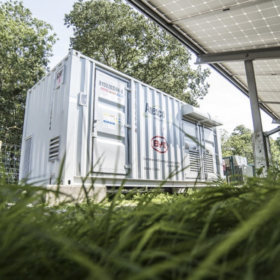Top News
Taiwanese researchers unveil 31.5%-efficient perovskite-silicon tandem solar cell

Decision-making model for wind, solar projects in Saudi Arabia

US corporate funding for solar down 24% in 2024

Around 10% of the world’s inland reservoirs could host 22 TW of floating PV

Renewable energy plus storage auctions to gain traction in India
 Wind tunnel tests show spacing between panels is key to reduce soiling
Wind tunnel tests show spacing between panels is key to reduce soiling  Saudi Arabia commissions its largest battery energy storage system
Saudi Arabia commissions its largest battery energy storage system  The best tilt angle to improve PV module performance in world’s worst soiling accumulation zone
The best tilt angle to improve PV module performance in world’s worst soiling accumulation zone  Advansor launches CO2 plug-and-play heat pumps
Advansor launches CO2 plug-and-play heat pumps  Africa adds 2.5 GW of solar in 2024
Africa adds 2.5 GW of solar in 2024
China hits 277.17 GW of new PV installations in 2024
Europe posts record negative power prices for 2024 as renewables rise
The Hydrogen Stream: Algeria, EU nations plan Southern Hydrogen Corridor
Press Releases
The LEAPTING Intelligent Automatic Navigation PV Module Mounting Robot made a groundbreaking entry into the Australian market
TIANWU Series Liquid-Cooling All-in-One Energy Storage Earns UL9540A Certification, Setting a New Industry Safety Benchmark
JinkoSolar Named Preferred Supplier for World’s Largest Solar-Storage Project
Scatec signs 15-year CfD contract for Romanian solar portfolio
Opinion & Analysis
Featured
PV module prices at crossroads
Carbon dioxide removal portfolios enable reaching ambitious climate targets
In a new monthly column for pv magazine, the Lappeenranta-Lahti University of Technology (LUT) describes how carbon dioxide removal may support reaching climate targets from a portfolio perspective.
Jet stream shift brings gloom to Northern Europe in December
In a new weekly update for pv magazine, Solcast, a DNV company, reports that december brought striking contrasts in solar irradiance across Europe, with Northern Europe experiencing irradiance levels up to 30% below the already dim seasonal average, while regions south of Europe’s major mountain ranges saw irradiance up to 30% above typical levels.
‘Technical expertise is often questioned more rigorously when exhibited by women’
This week, Women in Solar Europe (WiSEu) gives voice to Brigite Gonçalves, Head of Utility-Scale PV Business Developer at Portugal’s EnergyCon. She says Women in the solar industry face unique challenges, such as underrepresentation in decision-making roles and the persistence of unconscious biases. “To achieve equity, the solar sector must prioritize structural changes, including accessible mentoring and sponsorship programs tailored for women,” she states.
Global solar module prices mixed on varying demand expectations
In a new weekly update for pv magazine, OPIS, a Dow Jones company, provides a quick look at the main price trends in the global PV industry.
Optimizing photovoltaic systems: Best practices for economic, technical key performance indicators
As the global solar energy industry grows, so does the need for accurate monitoring of performance and financial viability. The latest report by IEA PVPS Task 13, “Best Practice Guidelines for the Use of Economic and Technical KPIs,” provides a comprehensive framework to address this issue. This article explores the importance, methodologies, and applications of Key Performance Indicators (KPIs), with a focus on their role in optimizing PV systems.
Markets & Policy
Featured
Bangladesh launches 500 MW PV tender
Chinese PV Industry Brief: JinkoSolar, TBEA report lower profits
Five major Chinese PV manufacturers issued profit warnings this week.
US state attorneys general urge Congress to keep IRA clean energy credits
Seventeen US state attorneys general have urged Congress to retain clean energy tax credits, citing the Inflation Reduction Act’s (IRA) “catalytic” effect on economic growth, especially in Republican districts.
The best residential PV system configuration for Saudi Arabia
Researchers in Saudi Arabia have identified the best and optimum PV system configurations for the Saudi residential market. Their analysis investigated the capacity threshold that leads to a lower cost of electricity compared to grid electricity costs. They used NREL’s HOMER software to analyze the energy requirements of the residential units, the solar energy potential and weather characteristics of the selected location, and the financial parameters influencing a project’s profitability.
Malaysia opens bidding for 2 GW of large-scale solar
Malaysia’s Energy Commission has launched an open tender seeking 2 GW of large-scale solar projects, with capacities ranging from 10 MW to 500 MW, to support the nation’s clean energy transition.
Romania allocates €150 million for standalone battery storage rollout
The Romanian Ministry of Energy has announced a new round of funding from the Modernization Fund dedicated to battery energy storage systems.
Installations
Featured
Novel BIPV concept integrates louvers to enhance power production
South Africa adds 1.1 GW of solar in 2024
The South African Photovoltaic Industry Association predicts that deployment will accelerate as a strong pipeline of private and public utility-scale projects offsets the decline in installations from 2023 levels.
Denmark’s solar capacity surpasses 4 GW
Denmark installed 545 MW of solar in 2024, with utility-scale projects driving market growth, according to Danish solar association Dansk Solcelleforening.
French consortium building linear DC solar park along Rhône River
A consortium is installing an experimental linear solar park in shade house configuration in Vaucluse, southern France, using high-voltage direct current architecture to reduce electricity losses.
Uruguay launches tender for 75 MW solar park
Uruguay’s National Administration of Electric Power Plants and Transmissions (UTE) has kicked off a tender for a 75 MW solar project in Cerro Largo, with operations set to begin between March and June 2028. The bidding process will close in January 2026.
The best tilt angle to improve PV module performance in world’s worst soiling accumulation zone
Scientists have measured the performance of PV modules under strong soiling conditions in Saudi Arabia and have identified the most suitable tilt angles for improving power generation. They have also found that a key role is played by rain intensity, dust, sandstorms, and cloud cover.
Technology
Featured
Reducing silver use in heterojunction solar cells via low-cost copper wires
Brazil approves six labs for solar module testing
Brazil’s national accreditation body, Inmetro, has authorized six labs across the country to test solar modules.
Enecoat claims 30.4% efficiency for four-terminal perovskite-silicon tandem solar cell
The Japanese manufacturer said its tandem cell utilizes a top perovskite solar cell with an efficiency of 22.4% and 81% infrared transmittance.
Italian scientists show technical feasibility of solid oxide fuel cells in PV-driven residential buildings
The researchers conducted a case study on a solid oxide fuel cell system deployed in a nearly zero-energy single-floor villa with a size of 80 m2 located in southern Italy. They found that, in particular conditions of photovoltaic production, the system is not only able to meet the home electric loads, but also to inject surplus energy into the network.
Recycled silicon powder from end-of-life solar panels can be reused in anti-corrosion coating
Researchers in India have demonstrated a wet chemical process to recover silicon with high purity from end-of-life solar panels, which they used to make functionalized silica nanoparticles. Tests of the processed nanoparticles in anti-corrosion coatings showed a corrosion protection efficiency of 99.5 %, which they said was 200 times lower corrosion rate compared to uncoated silica nanoparticles.
The Hydrogen Stream: USGS unveils map of US geologic hydrogen resources
The US Geological Survey (USGS) has released its first map of potential geologic hydrogen reserves in the United States, while Plug Power has secured a $1.66 billion US government loan guarantee to scale low-carbon hydrogen production nationwide.
Manufacturing
Featured
MENA region hits 24 GW (AC) of total solar capacity
Chinese PV Industry Brief: Longi issues net loss warning for 2024
Longi has issued a profit warning for 2024, forecasting a net loss of up to $1.11 billion – a sharp decline from last year’s profit of $1.42 billion.
TOPCon IP battle intensifies with Qcells launching infringement notices
Qcells has launched an intellectual property (IP) dispute over alleged unauthorized use of its patented laser-enhanced contact opening (LECO) tech in tunnel oxide passivated contact (TOPCon) solar cells. The case underscores rising tensions in the PV industry over TOPCon patents.
Construction begins on 12 MW Swiss alpine PV project
Work has begun on the Swiss Madrisa Solar project, a 12 MW alpine PV installation located at an elevation of 2,000 m near a ski resort of the village of Klosters. It is part of the Solar Express initiative designed to boost domestic winter energy production.
A copper-bottomed answer to solar’s silver dependence
The solar industry has dragged its heels on the issue of silver-dependence for cell metallization, but China’s Jiangsu Xianghuan Technology (JXTC) is moving into commercial production with a copper plating process that overcomes many of the challenges that have limited interest from cell manufacturers.
Solis releases three-phase string C&I inverters with fuseless design
The Chinese inverter said its new inverters have an MPPT current of up to 54 A and support more than a 150% DC/AC ratio. The new products also feature a maximum efficiency of 98.8% and a European efficiency rate of 98.3%.
Energy Storage
Saudi Arabia commissions its largest battery energy storage system
Australian utility-scale battery deployment surges
Big BESS battery energy storage systems (BESS) are booming in Australia, with almost 5 GW of projects under construction last year, according Rystad Energy. While encouraging, it reports that the volume remains insufficient to overcome growing rates of renewable curtailment.
Pioneers in Irish solar energy
From modest beginnings in 2011, Power Capital Renewable Energy (PCRE) has become one of Ireland’s foremost independent power producers (IPPs). Joint CEO and co-founder Justin Brown told pv magazine that despite Ireland’s challenging environment for solar, the company sees a lot of opportunity and is taking full advantage.
All renewables PPA structures at a glance
German scientists have identified 18 typologies of power purchase agreements for the renewable energy market. Their research is intended to support policymakers, scientists and investors in implementing their own PPA analysis and choices.
Advansor launches CO2 plug-and-play heat pumps
The Danish manufacturer said its novel CO2 heat pumps can reach a water inlet temperature of 40 C and a water outlet temperature of 95 C. The systems have purportedly a combined coefficient of performance of up to 5.56.
SoliTek launches made-in-Lithuania, high-voltage C&I battery energy storage solution
The new 51.2 kWh modular storage system connects to European wholesale electricity markets such as NordPool and uses artificial intelligence (AI) to track and analyze dynamic tariffs. It offers three-phase backup and is virtual power plant-ready.




